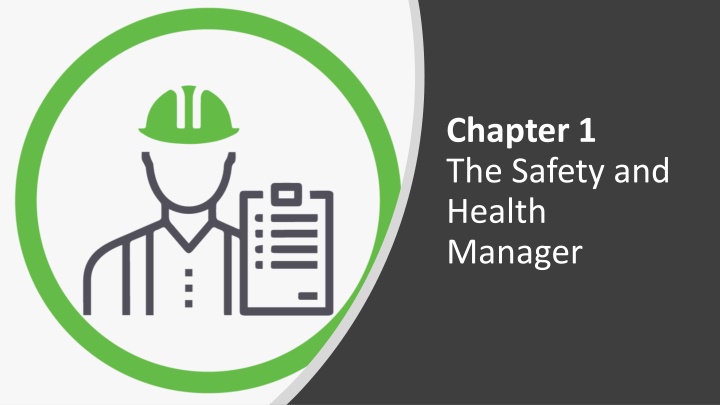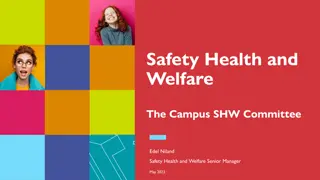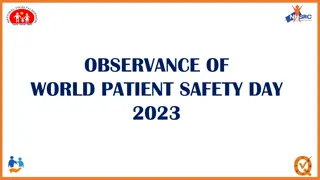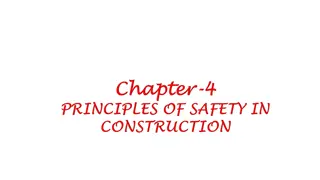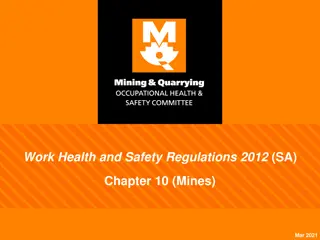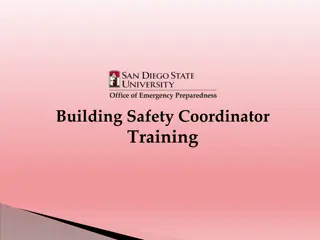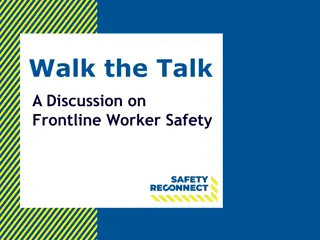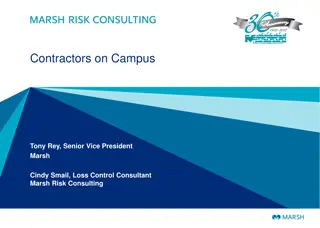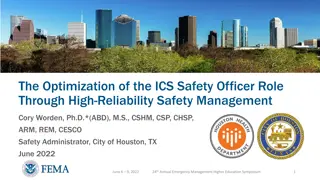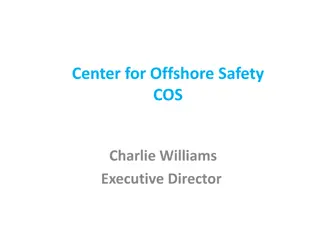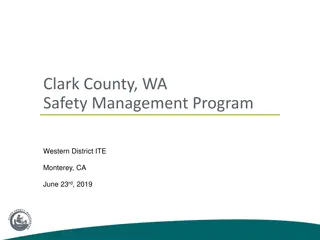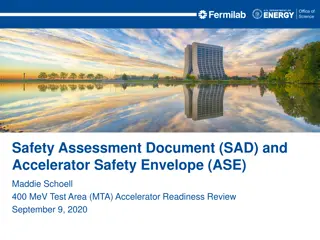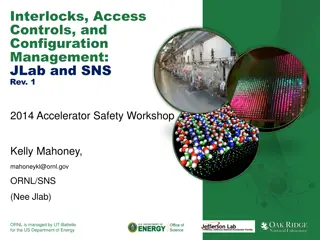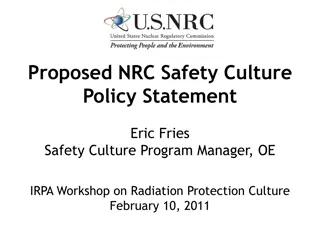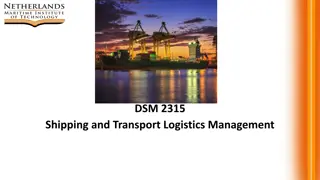Safety and Health Management Overview
This content provides an introduction to safety and health management, including the role of managers, key objectives, and realistic expectations for hazard prevention. It touches on the responsibilities before OSHA was established and the importance of understanding standards and persuading stakeholders.
Uploaded on Feb 22, 2025 | 2 Views
Download Presentation

Please find below an Image/Link to download the presentation.
The content on the website is provided AS IS for your information and personal use only. It may not be sold, licensed, or shared on other websites without obtaining consent from the author.If you encounter any issues during the download, it is possible that the publisher has removed the file from their server.
You are allowed to download the files provided on this website for personal or commercial use, subject to the condition that they are used lawfully. All files are the property of their respective owners.
The content on the website is provided AS IS for your information and personal use only. It may not be sold, licensed, or shared on other websites without obtaining consent from the author.
E N D
Presentation Transcript
Chapter 1 The Safety and Health Manager
Contents Introduction Reasonable Objective Safety versus Health Role in the Corporate Structure Resources at Hand
Introduction Management Responsibility, Commitment, and Support to Safety and Health Before OSHA: Plant Nurse (first aid/after the fact) Responsible for health Safety Manager little authority, ignored by management and worker In 1970, the Occupational Safety and Health Administration (OSHA) was created. OSHA was given the authority to establish the Safety and Health mandatory standards.
Introduction Only 10% of the standards generate 90% of the activity. Duties of safety and health manager include: Posting motivational signs Compiling statistics Analysis of hazards Compliance with standards Capital investment planning Safety and Health Managers need to know the why behind the standards to persuade management and employees that a given situation needs correction.
Introduction Example: Why use a hard hat?? Option 1: this is the rules and worker must follow!! Option 2: without a hard hat, you could be hit by objects falling from the upper floors accidentally.
A Reasonable Objective Is ZERO accidents and ZERO workplace hazards feasible?? There are three types of hazards that exist in the real world: Hazards which are physically infeasible to correct Hazards which are physically feasible, but economically infeasible to correct Hazards which are physically and economically feasible to correct
A Reasonable Objective Examples: Hazards which are physically infeasible to correct (bird entry into jet engines, exposure to radiation during x-ray procedures). Hazards which are physically feasible, but economically infeasible to correct (crosswalks on university campuses). Hazards which are physically and economically feasible to correct (airbags and anti-lock brakes). it is an unrealistic and naive strategy to attempt to eliminate all hazards.
A Reasonable Objective Option 1: accept the safety and health rationale as all they need to begin action to correct the problems. Anyone could do this, No need for safety and health manager! Deteriorating the safety and health manager s credibility with top management Better Option: Investigate all three areas (collect more data) You could identify serious electrocution or respiratory hazard unchecked, which require immediate action Only eliminate unreasonable hazards Questions??
Safety versus Health Safety deals with acute (sudden reaction to a sever conditions) hazards Health deals with chronic (long-term) hazards An acute effect is a sudden reaction to a severe condition; a chronic effect is a long-term deterioration due to prolonged exposure to a milder adverse condition Examples: Acute Hazards: Risk of amputation in a power press Chronic Hazards: Asbestosis Machine guarding is a _____ consideration. Airborne asbestos is a _____ consideration. Paint spray area, welding operations, and Industrial Noise?
Safety versus Health Some situations may be both a health and a safety hazard Example: industrial noise is usually a health hazard because it is usually the long-term exposure to noise levels in the range 90 to 100 decibels that leads to the permanent damage. But noise can also be a safety hazard because a sudden acute exposure to impact noise can injure the hearing system. Many chemical exposures have both acute and chronic effects.
Safety versus Health Industrial Hygienist concentrates on health hazards. Sophisticated Instruments Scientific Expertise Safety Specialist concentrates on Safety hazards. Industrial Process experience practical on-the-job Knowledge
Role in the Corporate Structure Responsibility may include: Security Personnel Management (or reporting to) Worker Training Statistics Job Placement Purchasing Department?? When purchases of equipment at bargain prices, the equipment may not be in compliance with current standards.
Role in the Corporate Structure Responsibility may include: Dealing with government agencies Compliance with environment protection (inside and outside the plant) Energy consumption global warming green engineering
Resources at Hand Professional Certification: Board of Certified Safety Professionals of America (www.bcsp.org) CSP Certified Safety Professional American Board of Industrial Hygiene (www.abih.org) CIH Certified Industrial Hygiene
Resources at Hand Professional Societies: American Society of Safety Engineers (ASSE) (www.asse.org) American Industrial Hygiene Association (AIHA) (www.aiha.org)
Resources at Hand System Safety In the mid-1950s, safety received emphasis as a system to be planned for and considered in every step in the production process. System Safety is considered essential in fields where an accident can be catastrophic, such as airlines, aerospace, and hospitals. System Safety Society (www.system-safety.org) National Safety Council Broad in scope than Occupational Safety Principle source for information about safety hazards Publishes comprehensive summaries of accident statistics (Injury Facts) (www.nsc.org)
Resources at Hand Standards Institutes Top 4: American National Standards Institute (ANSI) www.ansi.org National Fire Protection Association (NFPA) www.nfpa.org American Society of Mechanical Engineers (ASME) www.asme.org American Society for Testing and Materials (ASTM) www.astm.org
Resources at Hand Trade Associations Industry/Equipment Specific Provide Safety and Health Data and training. Sometimes accused of presenting biased data on safety and health to promote the industry s product Examples: American Iron and Steel Institute (AISI) American Metal Stamping Association (AMSA) American Petroleum Institute (API) American Welding Society (AWS)
Resources at Hand Government Agencies The consultation function is kept separate from the enforcement function in state agencies The Occupational Safety and Health Administration (OSHA) The main source for occupational safety and health standards Can answer question without identifying the caller identity. OSHA maintains a training institute for training the general public in voluntary compliance. The National Institute for Occupational Safety and Health (NIOSH) Research data on the hazards of specific materials and processes. NIOSH uses these data to write criteria for recommended new standards. Acts as a principal source of technical information for questions about occupational safety and health. The Consumer Product Safety Commission (CPSC) Ensures the safety of products going to the end consumer
Resources at Hand In KSA: Government standards: Saudi Labour law (Part 8) - 8 - 1439 Saudi Standards, Metrology and Quality Organization (SASO) Trade Associations: Occupational Safety, Health Association and Security (OSHAS) Regional standards: e.g., GCC Standardization Organization (GSO) International standards, example: ISO 45000 FAMILY OCCUPATIONAL HEALTH AND SAFETY Provides certifications for companies (e.g., SABIC is ISO 45000 certified). 10 161238 (
